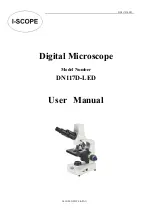
DN117D-LED
I-SCOPE OPTICS JAPAN
2
User Notice
Ⅰ
. Safety Notes
1.
Carefully open the box, avoid the accessor
i
es, like lens, dropping to ground and being damaged.
2.
Do keep the instrument out of direct sunlight, high temperature or humidity, dust
y
and easy
shaking environment. Make sure the stage is smooth, horizontal and firm enough.
3.
When moving the instrument, please use two hands to grip with the two sides of the microscope
body.
4.
When running, the lamp house and nearby parts will be very hot. Please ensure there is enough
cooling room for them.
5.
Make sure the instrument is earthed, to avoid lighting strike.
6.
For safety, be sure the main switch is in “O”(off) state before replacing the halogen lamp or the
fuse, then cut off the power, and do the operation after the lamp bulb and the lamp house
completely cool down.(
Specified: LED 3W
)
7.
Check the input voltage: be sure the input voltage which signed in the back of the microscope is
consistent with the power supply voltage, or it will bring a serious damage to the instrument.
8.
Use the factory supplied power cord, please.
II. Maintenance
1.
All the lenses have been well checked and adjusted. It is forbidden to disassemble them yourself.
2.
The nosepiece and coarse/fine focus unit have a compact and precise frame; please don’t
disassemble them as possibly as you can.
3.
Keep the instrument clean, wipe dust regularly, and be attention to avoid contaminating the
optical elements especially.
4.
The contaminations on the prism, as finger mark and oil, could be gently wiped with a piece of
soft cloth or tissue paper, gauze which has been immersed in pure alcohol or ether.
(
Note that
the alcohol and ether are highly flammable, do keep them away from the fire or potential
sources of electrical sparks, and use them in a drafty room as possible as you can.)
5.
Do not attempt to use organic solvents to clean the microscope components other than the glass
components. To clean them, use a lint-free, soft cloth slightly moistened with a diluted neutral
detergent.
6.
When using, if the microscope is splashed by liquid, cut off the power at once, and wipe up the
moisture.
7.
Do not disassemble any parts of the microscope, which will affect the function or decline the


















